Fossil Butte National Monument
Fossil Butte National Monument is a United States National Monument managed by the National Park Service, located 15 miles (24 km) west of Kemmerer, Wyoming, United States. It centers on an assemblage of Eocene Epoch (56 to 34 million years ago) animal and plant fossils associated with Fossil Lake—the smallest lake of the three great lakes which were then present in what are now Wyoming, Utah, and Colorado. The other two lakes were Lake Gosiute and Lake Uinta. Fossil Butte National Monument was established as a national monument on October 23, 1972.
| Fossil Butte National Monument | |
|---|---|
IUCN category V (protected landscape/seascape) | |
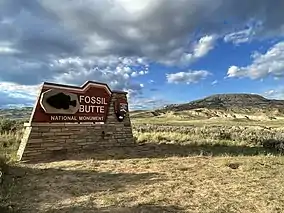 Fossil Butte National Monument | |
 Fossil Butte  Fossil Butte | |
| Location | Lincoln County, Wyoming, USA |
| Nearest city | Kemmerer, WY |
| Coordinates | 41°51′52″N 110°46′33″W |
| Area | 8,198 acres (33.18 km2)[1] |
| Established | October 23, 1972 |
| Visitors | 16,552 (in 2011)[2] |
| Governing body | National Park Service |
| Website | Fossil Butte National Monument |
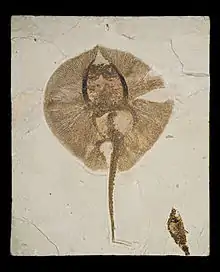
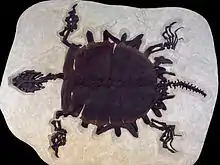
Fossil Butte National Monument preserves the best paleontological record of Cenozoic aquatic communities in North America and possibly the world, within the 50-million-year-old Green River Formation — the ancient lake bed. Fossils preserved include fish, alligators, bats, turtles, a dog-sized horse, insects, and many other species of plants and animals — suggest that the region was a low, subtropical, freshwater basin when the sediments accumulated, over about a 2 million-year period.[3]
Geologic formations

During the Eocene this portion of Wyoming was a sub-tropical lake ecosystem. The Green River Lake System contained three ancient lakes, Fossil Lake, Lake Gosiute, and Lake Uinta. These lakes covered parts of southwest Wyoming, northeast Utah and northwestern Colorado. Fossil Butte is a remnant of the deposits from Fossil Lake. Fossil Lake was 40 to 50 miles (64 to 80 km) long from north to south and 20 miles (32 km) wide. Over the two million years that it existed, the lake varied in length and width.[4]
Fossil Buttes National Monument contains only 13 square miles (8,198 acres (33,180,000 m2)) of the 900-square-mile (595,200 acres (2.409×109 m2)) ancient lake. The ancient lake sediments that form the primary fossil digs is referred to as the Green River Formation. In addition to this fossil-bearing strata, a large portion of the Wasatch Formation, river and stream sediments, is within the national monument. The Wasatch Formation represents the shoreline ecosystem around the lake and contains fossil teeth and bone fragments of Eocene mammals. Among these are early primates and horses.[4]
History
Coal mining for the railroad led to the settlement of the nearby town of Fossil, Wyoming.[5] When the fossils were discovered, miners dug them up to sell to collectors. In particular, Lee Craig sold fossils from 1897 to 1937. Commercial fossil collecting is not allowed within the National Monument, but numerous quarries on private land nearby continue to produce extraordinary fossil specimens, both for museums and for private collectors.
Exhibits
The Fossil Butte National Monument Visitor Center features over 80 fossils and fossil casts on exhibit, including fish, a crocodile, turtle, bats, birds, insects and plants. A 13-minute video is shown about the fossils found at the site and what scientists have learned. Interactive exhibits let visitors create fossil rubbings to take home, and a computer program discusses fossils, geology and the current natural history of the monument.
Activities
During the summer, lab personnel prepare fossils in public. Summer activities also include ranger programs, hikes, paleontology and geology talks, and participation in fossil quarry collections for the park.
_Fossil_Shack.jpg.webp)
A Junior Ranger program can be completed by children aged 5–12 (with exercises scaled to the child's age) in 3–4 hours. A highlight is hiking 3/4 mile up the butte to the dig, where interns from the Geological Society of America talk about their excavation and let children help them flake apart sedimentary deposits to discover fish fossils and coprolites.
List of fossil species recovered at Fossil Butte National Monument
Fish:
- Asterotrygon spp, an extinct stingray
- Diplomystus dentatus, an extinct ray-finned fish[6]
- Knightia spp, an extinct fish related to herring and sardines
- Seven extinct species of perch
- Heliobatis radians, an extinct stingray
- Notogoneus spp, an extinct bottom-feeding fish
- Crossopholis magnicaudatus (Commons), a 1-meter (40 inches) long predatory paddlefish
- Asineops squamifrons, called 'mystery fish'- allocated its own family Asineopidae
- Two extinct species of the family Osteoglossidae
- Amphiplaga brachyptera, an extinct freshwater fish
- Two extinct species of the genus Hiodon
Amphibians:
- Aleoamphiuma tetradactylum, an extinct omnivorous salamander
- Aerugoamnis paulus, an extinct frog
Mammals:
- Coryphodon
- Onychonycteris finneyi and Icaronycteris index, bats
- Heptodon, an extinct tapir
- Apatemys chardini, a tree-dwelling mammal similar to the lemur
- Protorohippus, an early horse-like mammal
- Palaeosinopa didelphoides, an otter-like carnivore
- Hyopsodus wortmani 'tube sheep', a small omnivore
- L. popoagicum, an extinct odd-toed ungulate
Birds:
- Frigate birds
- Pseudocrypturus cercanaxius, an extinct shoreline bird
- Gallinuloides wyomingesis, an extinct land fowl
- Primobucco mcgrewi, an extinct roller bird
- Four extinct species of parrot- Cyrillavis coldurnorum, Cyrillavis olsoni, Avolatavis tenens and Tynskya eocaena
Reptiles:
- Afairiguana, an extinct anole
- Boavus idelmani, a small extinct snake
- Bahndwivici, Afairiguana avius and Bahndwivici ammoskius, extinct lizards
- Baptemys wyomingenis, an extinct river turtle
- Echmatemys wyomingensis, an extinct pond turtle
- Borealosuchus wilsoni and Tsoabichi greenriverenis, extinct crocodiles
- Three species of soft-shell turtles- Apalone heteroglypta, Axestemys byssinus and Hummelichelys guttata
- Baenidae, turtle
Plants:
- Palm trees
- Cattails
- Gyrocarpus spp
- Lagokarpos Lacustris, a type of distinct 'winged fruit' plant Lagokarpos found in lake deposits
- Ailanthus confucii
- Platycerium, a staghorn fern
- Salvinia preauriculata, a water fern
- Lygodium kaulfussi 'climbing fern'
- Nelumbo spp
- Chaneya tenuis; a genus of uncertain affinities
)_(17975178659)_Chaneya_tenuis.jpg.webp) †Chaneya tenuis
†Chaneya tenuis - Birthwort (species unknown)
- Soapberry
- Species similar to a walnut
Arthropods:
- Bechleja rostrata, an extinct species of shrimp
- Procambarus primaevus, an extinct species of crayfish
- Three unidentified species of spider
- Dragonflies
- Damselflies
- Crickets
- Other insects including bees and ants
Primary source:[7]
Gallery
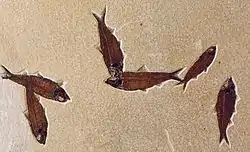 Knightia eocaena fish, about 10 centimetres (3.9 in) long. Knightia is the most commonly excavated fossil fish in the world.[7]
Knightia eocaena fish, about 10 centimetres (3.9 in) long. Knightia is the most commonly excavated fossil fish in the world.[7]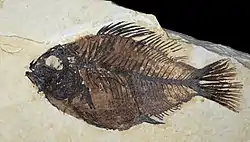
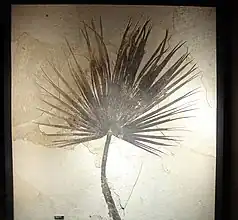
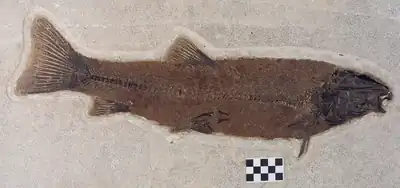
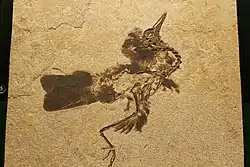 An unidentified fossil bird from FBNM, in the collections of the Field Museum
An unidentified fossil bird from FBNM, in the collections of the Field Museum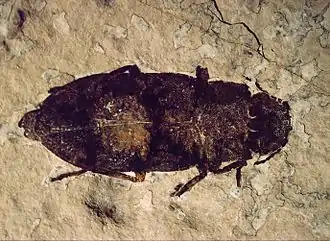 A well-preserved Buprestidae beetle (3.5 cm or 1.4 in long) from the FBNM collections. Other beetles, flies and Hemiptera bugs have also been found in the Fossil Lake sediments.[7]
A well-preserved Buprestidae beetle (3.5 cm or 1.4 in long) from the FBNM collections. Other beetles, flies and Hemiptera bugs have also been found in the Fossil Lake sediments.[7]
See also
Other NPS Cenozoic Era sites in the western U.S.:
- John Day Fossil Beds National Monument, Oregon
- Hagerman Fossil Beds National Monument, Idaho
- Agate Fossil Beds National Monument, Nebraska
- Badlands National Park, South Dakota
- Florissant Fossil Beds National Monument, Colorado
References
- "Listing of acreage – December 31, 2011" (XLSX). Land Resource Division, National Park Service. Retrieved May 14, 2012. (National Park Service Acreage Reports)
- "NPS Annual Recreation Visits Report". National Park Service. Retrieved May 14, 2012.
- Geologic travel guide from American Geological Institute
- "Geologic Formation". Fossil Buttes National Monument. National Park Service. Retrieved December 7, 2016.
- "Geologic Formations". National Park Service. Retrieved December 7, 2016.
- "Fossils - Fossil Butte National Monument". U.S. National Park Service. Retrieved January 29, 2019.
- Green River Formation Fossils at Fossil Butte